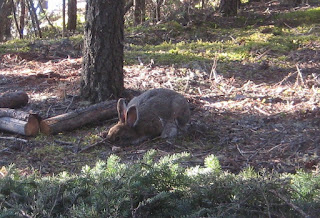The first portage of the trip needs only minor clearing.
One spot on the portage has a down tree whose bark a snowshoe hare ate during the winter, leaving hundreds of droppings.
An old wooden motor boat from many years ago that must have got swept away on the lake leading to the rapids.
The first rapids would be runnable ... except for two large trees across the channel. An example of why rapids must be checked before entering.
After portaging the first rapid, I run the last four. Thankfully I do not have to portage around them as the trails are all under water. I check every rapid thoroughly before deciding to run, walking to the shore in as many places required to see all of the rapid. After each rapid, I bail and sponge most of the water from the canoe, about five litres in the second and third rapids, and 20 litres in the fourth. I do not have to land to check the final fifth rapid, as it is almost level, the high water covering the boulders.
Camp 3, four km from the previous camp, including one portage 440 metres, and running four rapids ranging in length from 100 to 275 metres with a total length of 795 metres. At each campsite this spring, I hear ruffed grouse drumming during their mating season.
Drying gear that got wet while running the rapids. I use the bug tent because the mosquitoes become bothersome.
One of my "waterproof" bags that leaked at the top seam, then repaired with duct tape. This bag will get replaced when I get back to my vehicle in July. I learned years ago to check all the bags, especially those containing food, after having considerable water in the canoe from rapids, waves or rain. In one instance, my third food pack for the last month had some water in it but I did not open it for two months. The water wicked its way into some Ziploc™ closures of several items which moulded.
The Platypus GravityWorks™ 2.0L Water Filter System. I use this to fill my canteens with water free from bacteria and parasites, in an attempt to prevent getting sick as I did last year and having to be flown out. Rather than dipping it into the lake, it is easier to fill the "dirty" bag with raw water using the bailer. I disinfect the system once per week using bleach.
While sitting in camp, two snowshoe hares visit for several minutes. They are especially keen on eating the soil where I peed, the one hare virtually burying his head in the ground. This evening, I wake to hear a small? animal noise just outside my tent. I yell and bang the tent wall to scare it away. In the morning, I discover that a tent rope has been chewed off, probably by one of the hares.
An old burn area is a good spot to pick fireweed shoots. It is also a "good" place for blackflies, hence the hat scarf.
I caught these pike in the bay after collecting the fireweed. A gull patiently waits until I clean the fish.
My first fireweed salad and pike meal of the season ... mmm good!
On May 30, I hear for my first time this year, Canada geese flocks flying north.
On my last night at camp 3, I hear two wolves in the distance, howling three times over a period of several minutes in the wee hours of the morning. There is so much thick bush here, I wonder how they manage to get enough game to eat. It must be a hard life.





































